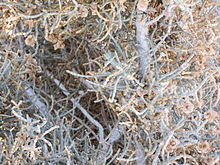| Anabasis articulata | |
|---|---|

| |
| Anabasis articulata, fruiting | |
| Scientific classification | |
| Kingdom: | Plantae |
| Clade: | Tracheophytes |
| Clade: | Angiosperms |
| Clade: | Eudicots |
| Order: | Caryophyllales |
| Family: | Amaranthaceae |
| Genus: | Anabasis |
| Species: | A. articulata |
| Binomial name | |
| Anabasis articulata (Forssk.) Moq. | |
Anabasis articulata is a plant of the genus Anabasis. It a salt-tolerant xerophyte that is found in the Syrian Desert. Bedouins often use the plant's ashes as a soap substitute.

The plant is also known for its medical properties. Algerian traditional medicine practitioners use the plants leaves to make anti-diabetic decoction.
References
- "Anabasis articulata". Encyclopedia of Life. Retrieved 5 February 2015.
- Mohammed Al-Oudat; Manzoor Qadir. "Halophytic flora of Syria" (PDF). ICARDA Corporate Systems. Archived from the original (PDF) on 4 March 2016. Retrieved 5 February 2015.
- Bailey, Clinton; Danin, Avinoam (1981). "Bedouin Plant Utilization in Sinai and the Negev". Economic Botany. 35 (2). Springer on behalf of New York Botanical Garden Press: 157 (4-g). JSTOR 4254272.
- N Kambouche; B Merah; A Derdour; S Bellahouel; J Bouayed; A Dicko; C Younos; R Soulimani (2009). "Hypoglycemic and antihyperglycemic effects of Anabasis articulata (Forssk) Moq (Chenopodiaceae), an Algerian medicinal plant". African Journal of Biotechnology. 8 (20).
| Taxon identifiers | |
|---|---|
| Anabasis articulata |
|
This Amaranthaceae article is a stub. You can help Misplaced Pages by expanding it. |